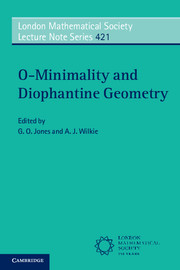Book contents
- Frontmatter
- Contents
- Preface
- 1 The Manin-Mumford Conjecture, an elliptic Curve, its Torsion Points & their Galois Orbits
- 2 Rational points on definable sets
- 3 Functional transcendence via o-minimality
- 4 Introduction to abelian varieties and the Ax–Lindemann–Weierstrass theorem
- 5 The André-Oort conjecture via o-minimality
- 6 Lectures on elimination theory for semialgebraic and subanalytic sets
- 7 Relative Manin-Mumford for abelian varieties
- 8 Improving the bound in the Pila-Wilkie theorem for curves
- 9 Ax-Schanuel and o-minimality
8 - Improving the bound in the Pila-Wilkie theorem for curves
Published online by Cambridge University Press: 05 August 2015
- Frontmatter
- Contents
- Preface
- 1 The Manin-Mumford Conjecture, an elliptic Curve, its Torsion Points & their Galois Orbits
- 2 Rational points on definable sets
- 3 Functional transcendence via o-minimality
- 4 Introduction to abelian varieties and the Ax–Lindemann–Weierstrass theorem
- 5 The André-Oort conjecture via o-minimality
- 6 Lectures on elimination theory for semialgebraic and subanalytic sets
- 7 Relative Manin-Mumford for abelian varieties
- 8 Improving the bound in the Pila-Wilkie theorem for curves
- 9 Ax-Schanuel and o-minimality
Summary
Suppose that f : (a, b) → R is an analytic function definable in an o-minimal expansion of the real field, and suppose that f is transcendental, that is that there is no nonzero polynomial P such that P(t, f(t)) vanishes identically. The Pila-Wilkie theorem applied to the graph of f says that for all ∊ > 0 there is a c > 0 such that for all H ≥ 1 there are at most
cH∊
rationals q in (a, b) of height at most H such that f(q) is also a rational of height at most H. See one of Wilkie's contributions to this volume for a discussion of this result, and its proof. The analyticity isn't necessary, and certainly isn't true piecewise of definable functions in general (indeed, they needn't even be piecewise infinitely differentiable, see [12]). But all the functions we will meet later are (possibly piecewise) analytic, so we may as well assume it from the beginning.
It is reasonable to ask whether the cH∊ bound in this result can be improved, say to a bound of the form c(logH)n for some c, n > 0. In fact, this sort of improvement is not possible. Constructions due to Surroca [19, 20] and to Bombieri and Pila [17] show the following. Suppose that ∊ : [1, ∞) → R is strictly decreasing and tends to 0. Then there is a transcendental real analytic function f on [0, 1] (that is, f has an analytic extension to a neighbourhood of [0, 1]) and an increasing sequence H1,H2, . . . of positive integers such that for each positive integer i there are at least
rational points (q, f(q)) on the graph of f of height at most Hi.
- Type
- Chapter
- Information
- O-Minimality and Diophantine Geometry , pp. 204 - 215Publisher: Cambridge University PressPrint publication year: 2015



